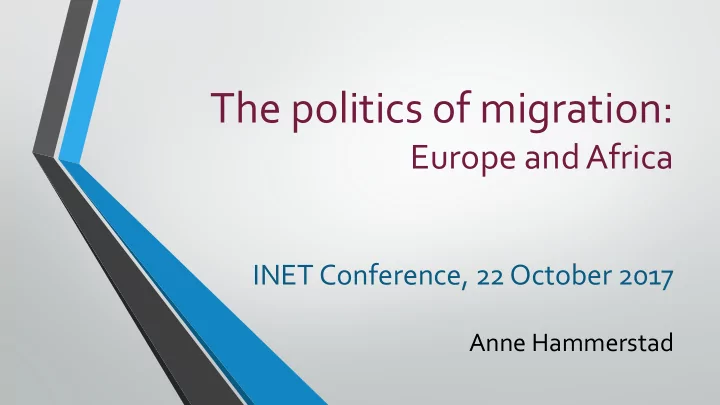

The politics of migration: Europe and Africa INET Conference, 22 October 2017 Anne Hammerstad
The politics of migration • The political repercussion of refugee, asylum and ‘irregular’ migration flows to the EU • Europe’s ‘migration crisis’ • Internal response • External repercussions: EU relationships with African countries
Europe’s migration crisis: Irregular migration across the Mediterranean to Greece, Italy • In proportion to overall number of international migrants, boat migrants have a seemingly outsized political effect • EU had around 55 million international migrants in 2015 • Jan 2015 until today: ca 1,5 million arrivals across the Mediterranean, most in a six month period in late 2015 and early 2016 • But • Irregular migrants form a larger proportion of new arrivals • They explain a lot of the growth in net migration into the EU, as opposed to EU citizens moving between EU countries • Boat migrants are a particularly visible, chaotic, form of migration •
Building up to the 2015 migration crisis • Rising number of international ‘irregular’ migrants from 2010 • ‘Mixed flows’, but depicted primarily as economic migrants • After a lull, a sharp rise in conflict & displacement • Record displacement (still rising) combined with record South-North migration (peaked in 2005-10 period) • Pressure on refugee host states in EU’s neighbourhood • 3.7 mill Syrian refugees in the region by end-2014 Scene set for Europe’s refugee and migration crisis
Syria: Concentric circles of flight (2015) 900,000 asylum seekers in Europe 4.8 mill regional refugees 6.6 mill IDPs 13.5 million rely on humanitarian assistance
Arrivals to Greece in 2015
From UNHCR
The situation in the EU at the start of 2016 • 1.3 million asylum seekers in EU • Majority to Germany, after lifting Dublin requirement in August • No progress on relocation, hotspots or other common EU measures • Unilateral border closures starting with Hungary, Oct. 2015 • Mood shifts: Terror attack in Paris, Nov. 2015; New Years Eve in Cologne
Border closures and EU-Turkey deal • Put an effective stop to the migrant trail, almost from the moment Macedonia closed its border in late February • Norway, 2016: The lowest level of asylum seekers since 1997 • 20 March 2016: EU-Turkey deal • Around 50-60,000 stuck in Greece • Not clear how long the deal will stick, but not clear it needs to…
Effect of border closures and EU-Turkey deal
EU internal repercussions • Anti-migrant sentiments, nationalism, on the rise (not just in EU) • Brexit, Trump, Austria, Poland, Hungary… • Rise of far-right, response of main-stream parties • Stricter asylum rules across Europe • Denmark’s Jewellery law; curbs on family reunion; protection short of asylum • Suggestions of scrapping asylum system for quotas • More forced returns, particularly to Afghanistan • EU burden sharing not working • East-West differences • Pressure on ‘free movement’ pillar – UK Brexit • External EU border control, but little internal cooperation • Sealing off Greece and, increasingly, Italy from onward movement • EU in security mode: Deterrence, interception, detention, border control
EU-Africa relationships • Migration dominating the EU’s agenda vis-à-vis Africa • All EU-AU summitry since Malta 2015 • Replicating the spirit of the EU-Turkey deal in Africa, esp. Libya • Stopping the boats • Pushing de facto EU border control to Libya’s southern border • Deterrence by allowing stranded migrants to suffer in limbo • Migration ‘compacts’ with priority countries : • Long term ambition: reduce irregular migration incentives through economic growth, job creation, formal migration opportunities, etc. • Current focus: border control, crack-down on smugglers (and the migrants they smuggle), return agreements.
A skewed relationship • EU diplomatic & aid focus shifting north from sub-Saharan Africa • More humanitarian assistance to fragile & conflict affected states • Partly driven by containment agenda • Migration priorities increasingly influencing aid agenda • Positive long-term development initiatives to reduce migration is not easy to achieve/measure – likely a wasteful/ inefficient development strategy • Fall-back on support for border control, policing, repressive measures • Some African countries have better bargaining chips, but the EU’s migration control agenda facilitates a highly transactional relationship open to abuse
Kenya’s announcement to close Dadaab Official statement, 11 May 2016:
Some concluding thoughts • Deterrence sort of works, for now and at a cost • Longer-term migration pressures from Africa to Europe will not go away • Sustainable Development Goals: link between international migration and sustainable development • More positive, mutually beneficial policies need to be put in place • But that depends on EU countries’ internal migration debates (and a recognition that economic sustainability and political sustainability of immigration levels are not necessarily the same) • From immigration panic to migration control
Interwar period: hostility to refugees after record number of migrants in the preceding century
Recommend
More recommend